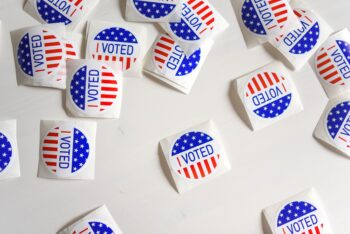
Mapping Voter Suppression: An Interview with Gena McClendon
Gena McClendon, a speaker on our Geography Awareness Week panel about mapping social justice, talked with me about the history of voter suppression, its enduring impact on our election process, and mapping the problem of voter suppression. McClendon is the director of the Voter Access and Engagement and the Financial Capability and Asset Building initiatives at the Center for Social Development.

McClendon explained that voter suppression is rooted in the U.S. Constitution. From its conception, our Constitution was an exclusive document.
“It only included white men primarily and at that time,” McClendon said, “African Americans counted for five-eighths of a person. So voter suppression is based in racism, literally systemic racism.”
Since the Constitution’s ratification, there have been amendments to it addressing the right to vote:
- 13th Amendment abolished slavery: Neither slavery nor involuntary servitude, except as a punishment for crime whereof the party shall have been duly convicted, shall exist within the United States, or any place subject to their jurisdiction.
- 15th Amendment expanded voting to all male citizens: The right of citizens of the United States to vote shall not be denied or abridged by the United States or by any State on account of race, color, or previous condition of servitude.
- 19th Amendment expanded voting to women: The right of citizens of the United States to vote shall not be denied or abridged by the United States or by any State on account of sex.
- The Voting Rights Act: While the Constitution was the primary vehicle of voter suppression to this point, ratifying these amendments didn’t put an end to it. When states were no longer able to deny the vote to Black people, direct efforts were put in to keep Black people from voting through discriminatory practices ranging from misinformation and literacy tests to full-on violence.
Although the Civil Rights Act passed in 1964, ending the segregation of public spaces, it did not explicitly address voter suppression. The Civil Rights movement continued to advocate for voting rights, an issue illuminated for every citizen when Alabama police violently attacked the peaceful Selma-Montgomery march, which set out to increase Black voter registration.
This led President Lyndon B. Johnson to call for reform, and he signed the Voting Rights Act in August of 1965. It banned the use of literacy tests to deny the right to vote and has been amended to further protect voters. Section five of the act requires jurisdictions to obtain preclearance from the U.S. attorney general before enacting any changes to voting in an attempt to thwart discrimination and voter suppression.
McClendon described how in 2013 preclearance was removed from the act when the Supreme Court held up state’s rights in Shelby County vs. Holder.
“Before the ink was dry, states put in voter ID laws. We had 25 or 30 different states that would immediately do things like change their polling place locations or they had voter ID laws or if they have early voting, they decreased the period of time you had to early vote. Maybe it was two weeks and they changed it to one week. Fast forward to today. Now you have tactics like what happened in Florida recently (sending out threatening letters), and what’s happened in Michigan (robo calls to people who lived in urban areas like Flint and Detroit saying, if you register to vote your credit card companies are going to know where you are, etc.). What’s happened in Wisconsin, in particular with the nationalists threatening people going into polling places…. It is very heavy handed. All of those things are targeted to Black people.”
Jennifer Moore: Tell me about your work on voter suppression:
McClendon: We started out doing presentations with different groups about voting, educating people about the processes and making sure that they register to vote and helping them understand what the policies are. The center did a couple of webinars with elected officials to help people understand the nuances of voting in person versus absentee and mail-in ballots. We did this early on to really help people understand that they have options. After that, it became more about the ballot initiatives, what’s on the ballot, and education on knowing your rights and knowing the laws.
We wanted to educate on more than just the candidates, but also on ballot initiatives like amendment three, for example. I spent a lot of time talking to different groups about how to get information about the judges in the race. Lately we’ve really been pushing the in-person absentee voting more than anything else and recruiting people to be poll workers or engage with the election protection.
At the Brown School, Dean McKay is allowing faculty and staff to be poll workers or participate in election protection at polling places on Election Day without using vacation time. They can be roving poll monitors or they may be a poll monitor, standing in one place holding up a sign. Another component that we have now but didn’t have before is social media monitoring, because there’s so much out there, disinformation and misinformation. We’ve really been focused on trying to get as many people as possible to sign up and participate with election protection.
Moore: You and your team created a map called Voter Access and Engagement. Tell me what led you to map the issue.
McClendon: St. Louis is very, very segregated. Initially what happened is in 2008, when Barack Obama was running for office, the center director and I volunteered to help out at the polls. When I went to vote in my location, in University City, which is a mixed community, I waited in line an hour. When I went up in North County, I was in Jennings, and people were in line for hours. There were broken machines. They ran out of paper ballots. It was the first time I really realized that this sort of thing happened in Black neighborhoods.
After the current administration got in, we started thinking about our work and how it would change. I suggested we could do something around voter suppression, and the center director (Michael Sherraden) agreed, because social work has been intimately involved in the Voting Rights Act and with the 19th amendment. I started thinking, how do you find out about voting? If you didn’t grow up in a household where people vote, how are you influenced to do it one way or the other? So it was that, and the racism that I knew that existed.
First, I just wanted to see the evidence in real time, what it would look like. I took a GIS workshop with Aaron Addison at one time and remembering that, I thought we should map this. That’s when I reached out to Data Services. I started thinking about how long it takes people to get from point A to point B on the bus. When the voter ID law came out in 2016, I thought, people don’t have IDs. Where are they going to go? The DMV office in north city moved out to Ferguson or Florissant, so now people have to go all the way out there to get driver’s licenses. I wondered if it was intentional.
We hired WashU student Austin Tolani (class of 2020) and started to build out those maps looking at voter turnout data for 2012, 2014, and 2016 and started to see a map where the majority of people were voting. That was one piece. Because we wanted an intentional focus on race, we decided that we needed look at income too. We had those two dynamics, we looked at high-population Black and high-population white, low income and high income, and that’s how we picked those polling places. We used U.S. Census tract data, and we triangulated it based on St. Louis City and the St. Louis region, the areas that have the lowest income or poverty rates. Austin did some great work for us.
Moore: What is the value of mapping social justice issues?
McClendon: It tells a story. So people learn in different ways. They need to read it. They need to see it. When people are able to see a map, and they understand what they’re looking at, it’s a great storyteller. There are so many things that you can map with justice issues and voting, criminal justice issues, racism. Look at the article the Economic Policy Institute did, “The Making of Ferguson: Public Policies at the Root of its Troubles.” We’re talking about redlining. We’re talking about laws on the books. That should be mapped.
This interview was edited for brevity and clarity.
If you would like to read another recent article about Gena McClendon’s work, check out Rosalind Early’s piece in The Source: Fighting Voter Suppression.
